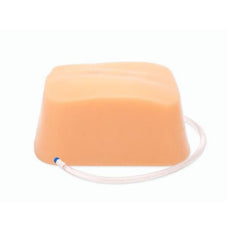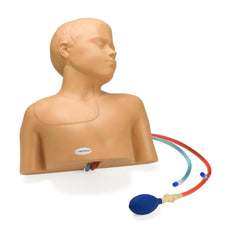Your shopping cart is empty.
Pediatric Regional Anesthesia and Central Line Ultrasound Training Model
Our realism makes your training better.
Blue Phantom’s simulated tissue, SimulexUS™, matches the acoustic properties of human tissue, providing clinicians with an extremely realistic training scenario. Use your ultrasound system without having to adjust the ultrasound system controls unrealistically. No computer simulation or software necessary. Each of our training models is designed to offer users of all levels superior realism, reliability and durability.
Better training at a lower cost.
Pediatric Regional Anesthesia Central Line Model offers anatomically correct brachial plexus and vascular access anatomy of the upper thorax and neck. This next generation ultrasound mannequin contains improved anatomy for nerve blocks including the supraclavicular nerves, interscalene nerves, infraclavicular nerves and enhanced access of the posterior interscalene nerve block approach. Vascular access anatomy includes the internal jugular vein (IJ), brachiocephalic vein, subclavian vein, axillary vein, carotid artery, subclavian artery and axillary artery. The model can be accessed via the internal jugular (IJ), subclavian, infraclavicular and supraclavicular approach as well as the axillary vein. The simulated superior vena cava, right atrium and right ventricle offer users the ability to fully thread guidewires, dilators and catheters without resistance just as you would expect with a live patient. Pediatric central line simulator also includes internal landmarks such as the trachea, suprasternal notch, manubrium and clavicle. This model is excellent utilizing traditional external landmarks for blind insertion central line placement or using ultrasound to guide the central venous access procedure. The brachial plexus can be injected with simulated anesthetics to verify needle tip location and to practice the entire anesthesia procedure. Injected simulated anesthetics are expelled allowing for repeated use.
Arterial pulsation can be simulated via the manual hand bulb to differentiate between arteries and veins via ultrasound. Users can also add the optional fully integrated automated pump system for additional ease. The veins in our adolescent central line mannequin are also compressible using mild pressure while the arteries remain uncompressed. Vessel identification is made easy by immediate positive fluid flow of the vein versus artery. The venous system is prefilled with blue fluid and the arterial system is prefilled with red fluid. Users can positively identify the targeted vessels and receive immediate feedback as to successful or unsuccessful vascular access. Re-fill venous and arterial fluid removed during central venous catheter procedures by using the provided QuickFill™ ports or and I.V. bag to continually refill the vessels during training.

GTSimulators by Global Technologies
CAE Healthcare Authorized Distributor.

0.0 lb
🎄 HOLIDAY SAVINGS - Ends Dec 31 🎄
Discount is automatically applied at checkout.
Pediatric Regional Anesthesia and Central Line Ultrasound Training Model
Item # BPP770-HP
$4,515.00
Need an estimate?
Click Add To Quote

Features & Specifications
-
by
A trusted GT partner -
FREE Shipping
U.S. Contiguous States Only -
Gov't pricing
Available upon request
Frequently Bought Together
Pediatric Regional Anesthesia and Central Line Ultrasound Training Model
Blue Phantom’s new Pediatric Ultrasound Central Line and Regional Anesthesia Training Model is the most realistic central line and nerve block simulator available anywhere. Using our innovative LifeCast™ modeling approach, the model provides the most realistic external landmarks while the internal anatomy is based on digital human files of a 6-year-old child. This ultra-durable mannequin incorporates all the anatomy required to gain proficiency in using ultrasound for pediatric central line placement and peripheral nerve blocks. This model is excellent for both ultrasound guided and blind insertion central line procedural training. Our ultra-durable self-healing tissue withstands tremendous use, minimizing the need for replacement parts. Blue Phantom allows clinicians to teach, practice and learn central line and regional anesthesia procedures repeatedly without the need to worry about cost per use. Perform complete central line placements of the internal jugular and subclavian vein - including needles, guidewires, dilation, and threading of catheters.Our realism makes your training better.
Blue Phantom’s simulated tissue, SimulexUS™, matches the acoustic properties of human tissue, providing clinicians with an extremely realistic training scenario. Use your ultrasound system without having to adjust the ultrasound system controls unrealistically. No computer simulation or software necessary. Each of our training models is designed to offer users of all levels superior realism, reliability and durability.
Better training at a lower cost.
Pediatric Regional Anesthesia Central Line Model offers anatomically correct brachial plexus and vascular access anatomy of the upper thorax and neck. This next generation ultrasound mannequin contains improved anatomy for nerve blocks including the supraclavicular nerves, interscalene nerves, infraclavicular nerves and enhanced access of the posterior interscalene nerve block approach. Vascular access anatomy includes the internal jugular vein (IJ), brachiocephalic vein, subclavian vein, axillary vein, carotid artery, subclavian artery and axillary artery. The model can be accessed via the internal jugular (IJ), subclavian, infraclavicular and supraclavicular approach as well as the axillary vein. The simulated superior vena cava, right atrium and right ventricle offer users the ability to fully thread guidewires, dilators and catheters without resistance just as you would expect with a live patient. Pediatric central line simulator also includes internal landmarks such as the trachea, suprasternal notch, manubrium and clavicle. This model is excellent utilizing traditional external landmarks for blind insertion central line placement or using ultrasound to guide the central venous access procedure. The brachial plexus can be injected with simulated anesthetics to verify needle tip location and to practice the entire anesthesia procedure. Injected simulated anesthetics are expelled allowing for repeated use.
Arterial pulsation can be simulated via the manual hand bulb to differentiate between arteries and veins via ultrasound. Users can also add the optional fully integrated automated pump system for additional ease. The veins in our adolescent central line mannequin are also compressible using mild pressure while the arteries remain uncompressed. Vessel identification is made easy by immediate positive fluid flow of the vein versus artery. The venous system is prefilled with blue fluid and the arterial system is prefilled with red fluid. Users can positively identify the targeted vessels and receive immediate feedback as to successful or unsuccessful vascular access. Re-fill venous and arterial fluid removed during central venous catheter procedures by using the provided QuickFill™ ports or and I.V. bag to continually refill the vessels during training.

GTSimulators by Global Technologies
CAE Healthcare Authorized Distributor.
SPECIFICATIONS:
ANATOMY:Size: 21.5" wide x 22.5" high x 9" deep (55 cm x 57 cm x 23 cm)
Weight: 28 lbs. (hand pump) (12.7 kg), 32 lbs. (auto pump) (14.5 kg)
WARRANTY:1 Yr Manufacturer's Warranty
Only use with CAE Blue Phantom Ultrasound Refill Fluid
Only use with 18-21 gauge, sharp, unbent needles
- Pediatric upper torso ultrasound central line and regional anesthesia mannequin
- Extremely realistic external and internal anatomy for ultrasound guided or blind insertion training on 6-year-old patient
- Excellent for training clinicians in the psychomotor skills associated with ultrasound guided central line placement training
- Superb imaging characteristics optimize your training; simulated tissue matches the acoustic properties of real human tissue
- For use with any ultrasound system, no computer simulation or software necessary
- Self-healing tissue offers users tremendous durability – minimizing the need for replacement parts and providing a low cost of ownership
ANATOMY:
- Regional anesthesia anatomy includes: supraclavicular nerves, interscalene nerves, infraclavicular nerves and
enhanced access of the posterior interscalene nerve block approach
- The brachial plexus can be injected with simulated anesthetics to verify needle tip location and to practice the entire anesthesia procedure
- Injected simulated anesthetics are expelled allowing for repeated use
- Venous anatomy includes: internal jugular vein (IJ), brachiocephalic vein, subclavian vein and axillary vein
- Arterial anatomy includes: carotid artery, subclavian artery and axillary artery
- Simulated superior vena cava, right atrium and right ventricle allows clinicians to fully thread guidewires and catheters without resistance
- Internal landmarks for superior realism include the trachea, manubrium and clavicle
- Veins are compressible using mild pressure while the arteries remain uncompressed
- Arterial pulsations simulated using provided hand bulb or optional integrated automated pumping system
- Positive fluid flow in the vessels; model is prefilled with red fluid in the arteries and blue fluid in the veins
- Easy to refill vessels with ultrasound refill solution using QuickFill™ ports
- Excellent imaging quality using any ultrasound system
- Practice using ultrasound system controls
- No special storage needs
- Patented technology
- Purchase includes 2 bottles of simulated blood refill solution; one red (arterial), one blue (venous). 235mls each bottle
- Soft storage included
WARRANTY:
Made in the USA
GTSimulators by Global Technologies
CAE Healthcare Authorized Distributor.

by — Item # BPP770-HP
Pediatric Regional Anesthesia and Central Line Ultrasound Training Model
$4,515.00
Add to Cart
Add to Quote




































